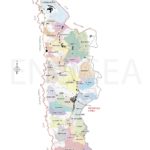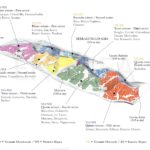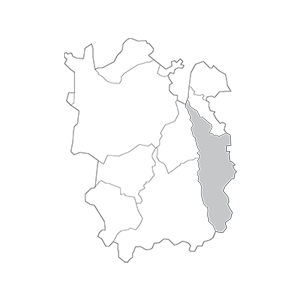Number of MGAs: 39
Number of Wineries: 29
The commune of Serralunga d’Alba, as can be seen in the 3D model below, is dominated by an extensive ridge that runs from the plain at the north to the southern border of the Barolo zone.
The ridge follows an almost direct path that can be easily replicated by clicking in succession on the thumbnails of the first three panoramic images. First without rotating them, then rotating only the third by 180 degrees to get an idea of just how close the extreme south of the ridge is. Then go ahead and rotate them as you like, but always concentrating on the simple but fundamental division of the communal territory into two opposite sides: the Eastern slops, on the right in pale blue, and the Western Slope, on the left in yellow.
1) The Eastern Slopes. Of the two, this is the least extensive, and, moving southward along the valley that leads to Sinio and Roddino, it tends to narrow as the vineyards climb more and more toward the top of the main ridge. Within it, four sectors can be distinguished: Cerretta, marked by an imposing and clearly visible crest around which other MGAs extend, such as Prapò, Teodoro, San Rocco and the eastern side of Sorano; the Gianetto ridge with Bricco Voghera and Brea; the broad area that ranges from the southfacing slopes of Cerrati to the east/southeast of Broglio, San Bernardo and Serra; and finally the two basins of Badarina, at the southernmost part of the ridge and on the opposite slope that hosts Francia and Boscareto.
2) The Western Slopes. Open and luminous in many places – notably between Marenca and Arione – these slopes are marked by a series of basins and secondary parallel ridges that tend to widen and become more imposing as you move toward the southern border of the commune. The first sector, which runs from Fontanafredda to Costabella, has lower altitudes and renders wines of more pronounced elegance (although in places like Sorano and San Rocco the tannins are already notable). The second, which includes Baudana and Meriame, have more than a few affinities with Cerretta, while the third ranges from the volume of Lazzarito to the more earthy character of Gabutti. The fourth, in the central part of the slope, is noted for wines with the floral notes of Margheria, the power of Marenca and the vertical austerity of Vignarionda. The fifth sector, at higher altitudes, is noted for wines of the classical elegance of Falletto and Francia (the latter a touch deeper), the tannic thrust of Boscareto, the blend of vigor and elegance of Ornato, and the measured minerality of Arione.


